Baking with Ancient Grains: A Quick Guide To 100% Kamut Bread
Kamut Bread made with 100% Fresh Milled Khorasan Wheat Berries, will it work? Ok, so if you have done any research on whole wheat berries, or whole wheat kernels, you probably have heard that the recommended wheat for a light and fluffy raised bread is a hard white or hard red wheat. This is because the hard wheat varieties have the capability of producing the most gluten without adding any additives. This got me experimenting…

Well, Kamut (Khorasan) Wheat happens to be one of my favorite wheat varieties. Also, generally it is known that Kamut is fairly low in gluten, but not quite as low as a soft wheat variety. So, I wanted to see for myself just how much gluten I could get from it. So, let’s get into it, and I will let you know my thoughts about my little experiment.
My 100% Fresh Milled Kamut Flour Bread
Firstly, let me start off by saying, I really love to play around with different grains and combinations of grains/wheats. This gives me the opportunity to experience the difference between each one, and not just take someone else’s word for it. And, I had a thought…
My Thought
I wonder if I take my favorite sandwich bread recipe, which you can find HERE . (This is also the very recipe that I make a couple times a week for my family.) And, what if I tried to make that same recipe with 100% Kamut flour that I milled myself. So, come with me on this little experiment, so we can see what happens. (spoiler- you can already see the end result in the pictures.)

Kamut / Khorasan Wheat Bread Recipe
This recipe will guide you through the process of making 100% Kamut bread, a delicious and nutritious option for those looking to incorporate ancient grains into their diet. Kamut flour is an ancient grain that has been gaining popularity in recent years due to its high protein content and nutty flavor.
Not only is Kamut bread delicious, but it’s also packed with nutrition. Kamut flour contains high levels of protein, fiber, and minerals like selenium and zinc. Plus, it’s easy to digest and may be a good option for those with gluten sensitivities.
Ingredients To Make This 100% Fresh Milled Kamut Bread
- 4 cups Fresh Milled Kamut Flour 480g (I milled 2&2/3 cups Kamut berries)
- 1&3/4 cup Warm Water (410g)
- 3 TBSP Light Extra Virgin Olive Oil
- 3 TBSP Sugar or Honey
- 1&1/4 tsp Salt
- 2 tsp instant yeast
Instructions To Make 100% Fresh Milled Flour Kamut Bread
- Firstly, measure out your wheat berries, and mill it into flour.
- Secondly, warm the water to about 90-100*F
- Then, add the water to stand mixer bowl, and add sugar, salt, and olive oil. Mix to combine.
- Next, add the flour to the stand mixer bowl, and start to mix on low until all the dry flour incorporated.
- Now, cover and let sit at room temperature for about 10-30 minutes (up to 2 hours.) This will allow the fresh milled Kamut flour to absorb the liquids.
- After the rest, add the yeast, and then start to mix the yeast until combined.
- Once the yeast seems incorporated, then turn mixer up to 2 to knead the dough. Typically with my recipes, I will say to knead until you get a window pane, however in this case, I never got a solid absolute window pane. (this is because Kamut has a lower amount of gluten.)
- Knead for about 10 minutes until the dough looks smoother and is a bit stretchy. (The dough should seem a bit sticky at this point still.)
- Now, cover the dough and let rise for 1-2 hours or until doubled in size.
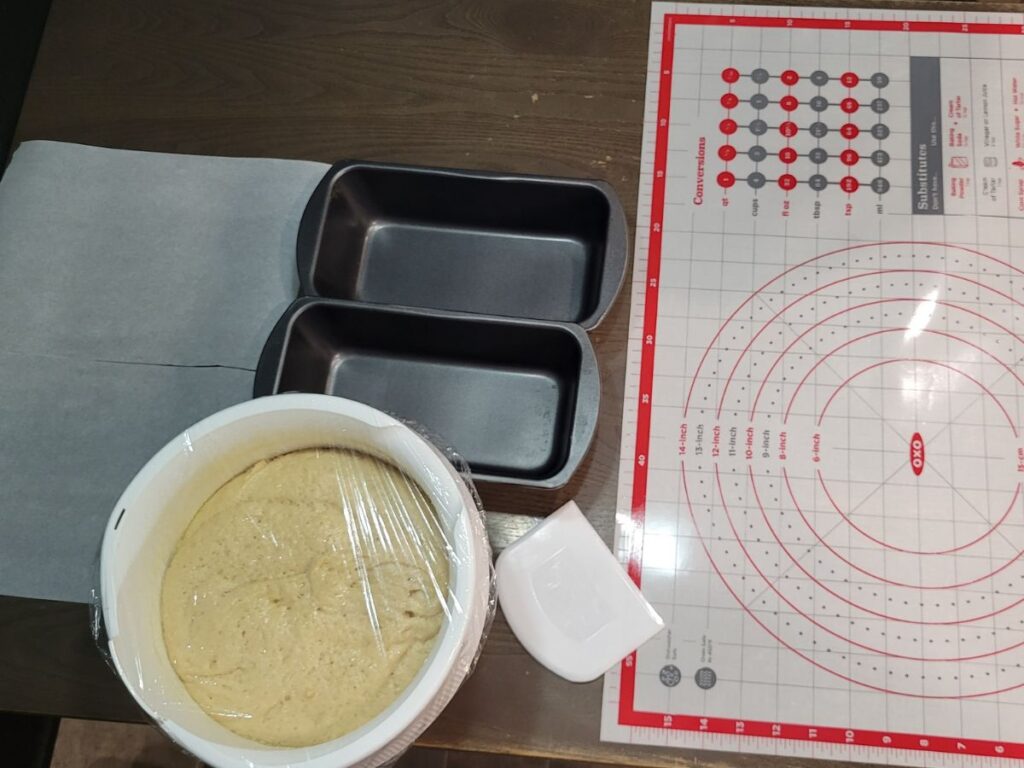
After The Dough Has Doubled
10. After the dough has doubled, take to a clean surface, and spread a little olive oil on it with your hands, and lightly coat your hands to help prevent the dough from sticking.
11. Then cut the dough in half, and press one of the dough pieces flat. Then roll it up to shape it into a loaf. Make sure there is some surface tension.
12. Repeat with the second dough piece.
13. Place each loaf in a 4 x 8x prepared baking bread tin. (I like to line mine with parchment paper.)
14. Then, cover each loaf ad let rise for 35-45 minutes.
15. During the end of this rise time, preheat the oven to 400*F.
16. Bake loafs for 20 to 25 minutes or until the internal temperature reaches 190*F.
17. Lastly, remove bread from oven, and remove from bread tins right away onto a wire cooling rack. (be careful not to burn yourself!)
18. Finally, let bread cool completely before slicing.
What Is The Difference Between Kamut and Khorasan Wheat?
Kamut and Khorasan wheat are technically the same thing. Kamut is the “name brand” a lot of people know it as, but the wheat variety is actually Khorasan Wheat. So, either way, you know you are getting the same wheat variety.
If you are interested in learning more about Kamut/Khorasan Wheat, I have a lot of info HERE in my post about making pasta with Kamut flour. I talk about the health benefits, and the benefits of Kamut, and dive into the history a bit as well.

What Did I Think About The 100% Kamut Bread?
Ok… So, my thoughts on this 100% Fresh Milled Kamut Flour Bread Recipe… Well, based on the taste, it was amazing! There was a buttery sweetness to the flavor. And, texture-wise, it was pretty great! It reminded me of some of my earlier bread loafs before I discovered that kneading to the window pane resulted me a softer fluffier loaf. (But, I digress, more on that in my window pane short video HERE. This was a game changer!)
So, next time, I think I will probably still add some hard white wheat variety and see just how much Kamut I can get in there. All while still keeping the gluten integrity intact. So, I can still get that soft and squishy loaf, but with the flavor, and benefits that the Kamut/Khorasan Wheat has to offer.
Conclusion
Thank you for following me along on this little experiment. Don’t forget to check out some of my other recipes and videos to learn more about milling your own flour, and all the recipes I have to offer. I am adding more every week!
Shop This Post
Checkout Some Of My Other Recipes
Spelt Peanut Butter Kiss Cookies

100% Fresh Milled Kamut Bread (Khorasan Wheat)
Equipment
- 2 4×8 bread tins
Ingredients
- 4 cups Fresh Milled Kamut Flour 480g I milled 2&2/3 cups Kamut berries
- 1&3/4 cups Warm Water 410g
- 3 TBSP Light Extra Virgin Olive Oil
- 3 TBSP Sugar or Honey
- 1&1/4 tsp Salt
- 2 tsp instant yeast
Instructions
- Firstly, measure out your wheat berries, and mill it into flour.
- Secondly, warm the water to about 90-100*F
- Then, add the water to stand mixer bowl, and add sugar, salt, and olive oil. Mix to combine.
- Next, add the flour to the stand mixer bowl, and start to mix on low until all the dry flour incorporated.
- Now, cover and let sit at room temperature for about 10-30 minutes (up to 2 hours.) This will allow the fresh milled Kamut flour to absorb the liquids.
- After the rest, add the yeast, and then start to mix the yeast until combined.
- Once the yeast seems incorporated, then turn mixer up to 2 to knead the dough. Typically with my recipes, I will say to knead until you get a window pane, however in this case, I never got a solid absolute window pane. (this is because Kamut has a lower amount of gluten.)
- Knead for about 10 minutes until the dough looks smoother and is a bit stretchy. (The dough should seem a bit sticky at this point still.)
- Now, cover the dough and let rise for 1-2 hours or until doubled in size.
- After the dough has doubled, take to a clean surface, and spread a little olive oil on it with your hands, and lightly coat your hands to help prevent the dough from sticking.
- Then cut the dough in half, and press one of the dough pieces flat. Then roll it up to shape it into a loaf. Make sure there is some surface tension.
- Repeat with the second dough piece.
- Place each loaf in a 4 x 8x prepared baking bread tin. (I like to line mine with parchment paper.)
- Then, cover each loaf ad let rise for 35-45 minutes.
- During the end of this rise time, preheat the oven to 400*F.
- Bake loafs for 20 to 25 minutes or until the internal temperature reaches 190*F.
- Lastly, remove bread from oven, and remove from bread tins right away onto a wire cooling rack. (be careful not to burn yourself!)
- Finally, let bread cool completely before slicing.
Video
*This post contains affiliate links, which means I make a small commission at no extra cost to you! As an Amazon Associate I earn from qualifying purchases. But I will only suggest items I actually Love and Have Used!

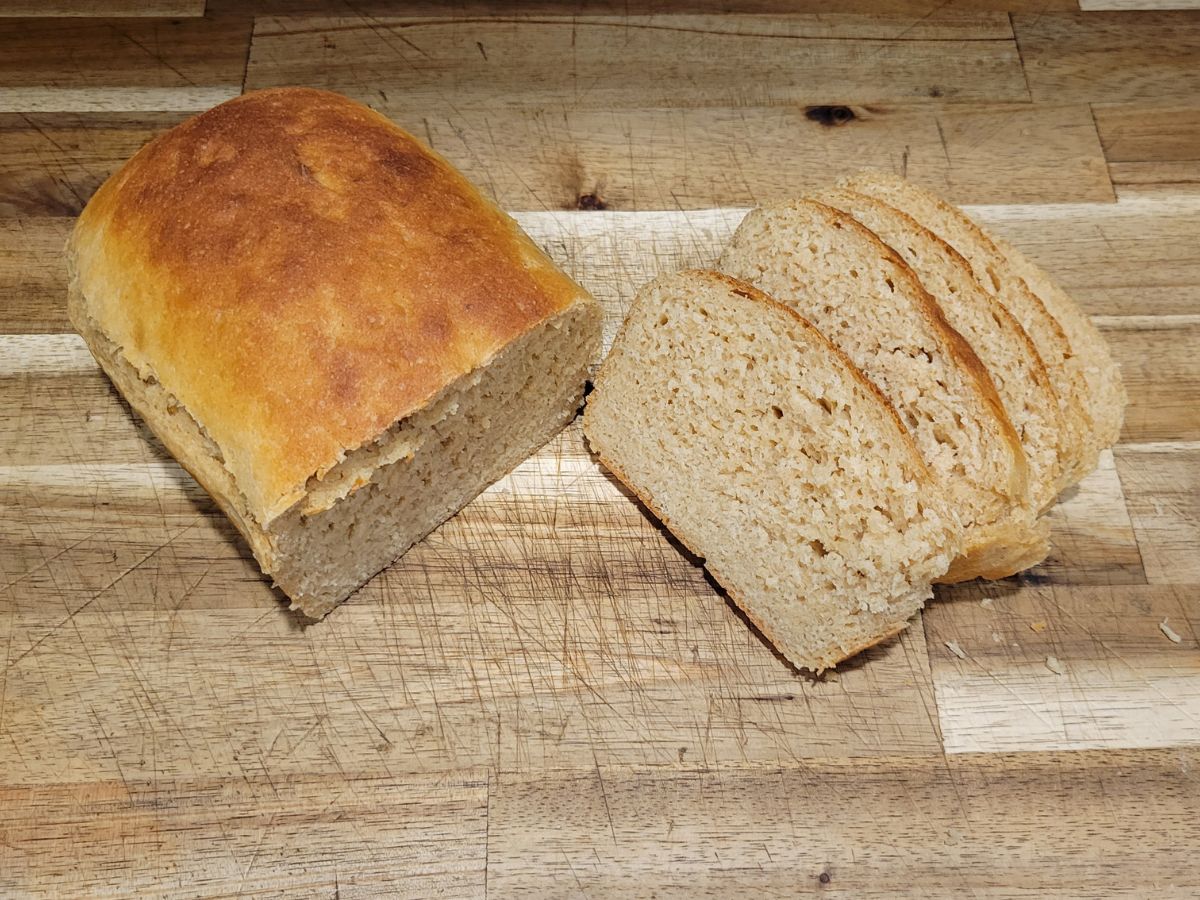

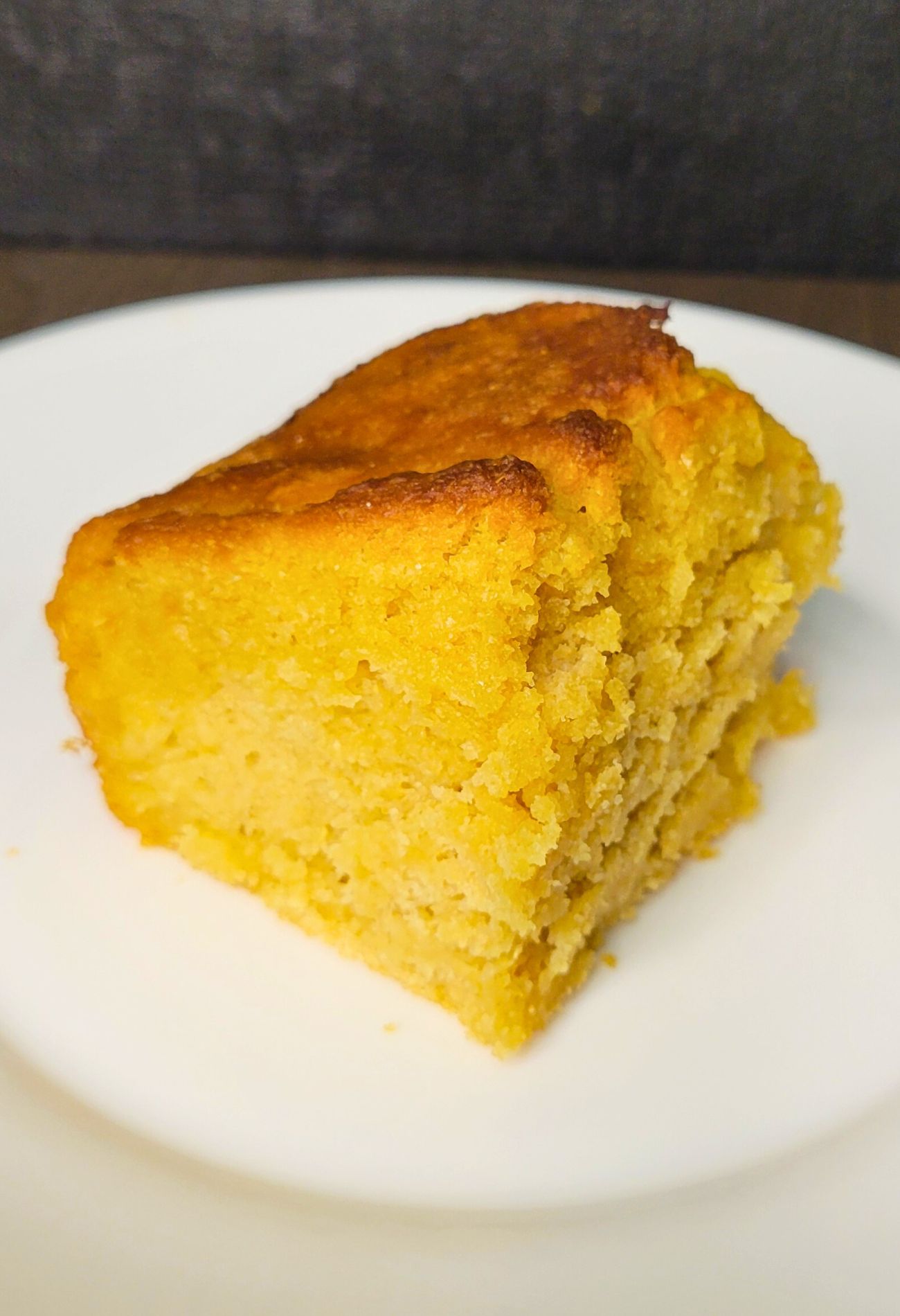



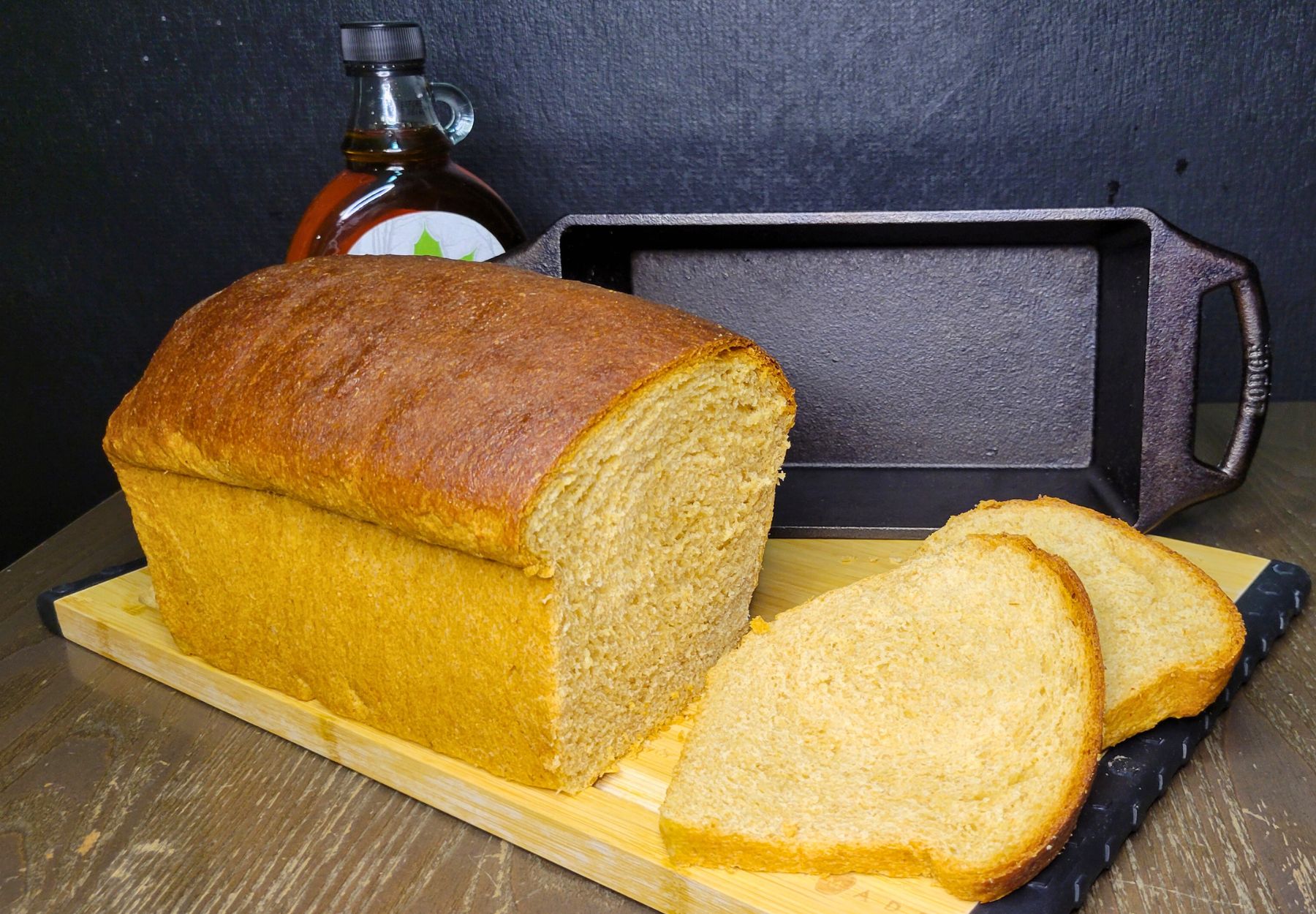
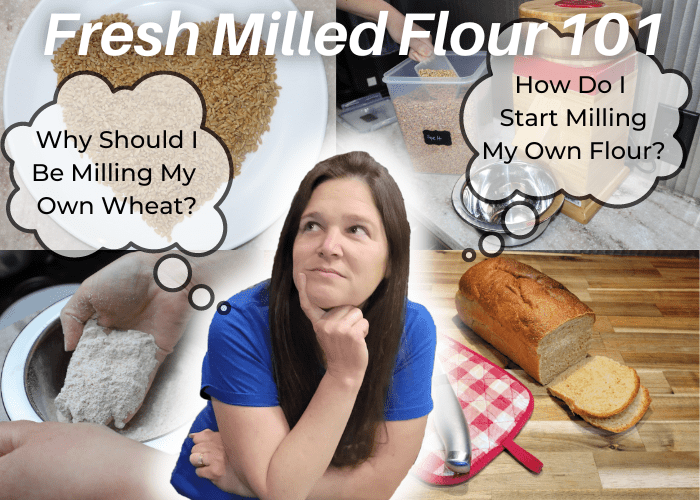
Hi can you give me an idea of how to make the kamut loaves without a bread machine. Thanks. I love kamut and make all my own organic whole-wheat loaves in a Dutch oven. Can I make it also without using sugar or honey?
I make this Kamut recipe without a bread machine. Maybe my video will help, here is the link https://youtu.be/dzjcavlulBw
I love Kamut as well! Yes, you can omit the sugar or honey! Hope that helps! Thanks!
I was wondering if I can use a sourdough starter instead of the yeast?
Yes, you could omit the yeast, add about 1/2 cup (115g) of active sourdough starter (that was heavily fed the night before) Then, just watch the rise times, they will be longer. Let me know how it goes!
First time milling Kamut so I tried this (and doubled because who doesn’t try a recipe for the first time and double it?)
I am amazed at how much like regular bread flour it handled! I haven’t seen my dough get that much stretch since I started milling!
Question on the measurement for 2 loaves in 8×4- I only got 3 loaves out of this on my doubling of the recipe. Did I not let it rise long enough on the first rise? Only sub for me was active dry vs instant and I adjusted 1.25x as is the way.
Thanks! I may now be hooked on Kamut!
Yes it is so delicious isn’t it! I love working with Kamut too. If you double the recipe it is likely you might only get 3 nice big loafs. My 2 loafs where a bit smaller than my hard white sandwich loafs. Or you could do 4 small loafs. Thanks!
This turned out fantastic! How could I adjust using traditional yeast?
I have had success making this exactly the same way, just with a longer rise time. But, if you prefer you can just bloom the yeast with some of the warm water and sugar during step 5 where you are letting the flour absorb the water.
Then add it in at step 6 for kneading. Hope that helps!
Thanks!
Excellent bread! Could use this recipe to bake in a Dutch oven?
Thank you! I have not tried this bread as a freeform loaf. I think it is possible to do in a Dutch oven, but it will have to be shaped very tightly. Because the Kamut doesn’t seem to hold it’s shape well. It may collapse. Let me know if you try it!
Wow! I have made this bread twice now and both times it has come out 10/10! My family and friends all love it. I will try doubling the recipe next time I make it because the two loaves don’t last long!
I buy my Kamut from Azure Standard.
Yay! I am so happy to hear that! Yes, I have been loving my Azure grains!
I’m so excited, my first bags of Azure grains will be mine in a couple of weeks. Thanks for mentioning your experience with their product.
Yay! It is so exciting! My pleasure! Thanks so much! 🙂
Hi! This bread is absolutely amazing and your instructions are very easy to follow. I have a question…how could I do a bigger loaf using this recipe? I have a 6×9 loaf pan that I would like to use to make the slices more like the size of regular bread. Thank you!
Hi! Thank you so much! I haven’t used the larger pans, because of the size of my oven. But, most people say with the larger loaf pans they will x1.5 my recipe and it will make 2 loaves. OR for the 2# loaf pans, just make one loaf out of this recipe rather than divide it into two loafs. Hope that helps!
How can I adjust the recipe to add some hard or soft white wheat with the kamut in this recipe? Thank you
You can add half Kamut and half hard white without any changes really. Hard white develops gluten, so the bread will have more of a structure to it. If you want to add soft white, that doesn’t develop gluten so I would only add a tiny amount. I do have a sandwich bread that is written for half Kamut and half hard white if you are interested in it. Here it is. https://grainsinsmallplaces.net/everyday-sandwich-bread-made-with-fresh-milled-flour-easy-recipe/
Do you know how I’d make this in a bread machine?
Pretty similar, make sure to put all the wet ingredients in first, then the fresh milled Kamut flour, and the yeast in a small well at the top. Give it a try, and let me know how it works! (It may need a double kneading cycle, stop and check it for stretchiness to decide if it needs to go again.)
This is the best recipe! My granddaughter told me to never buy bread from the store again, she’s 7. I usually make sourdough, but this is going to be a staple in our home. Your recipe is perfect. I wouldn’t change a thing.
Yay! I am so happy to hear this! That is wonderful! She knows what good food tastes like! Thanks so much! Happy Baking!
Thank you! Where do you buy your Kamut grains?
Hi! I have purchased form several places. Bread Beckers is great to get them if you are near N Georgia OR one of their Co-Op drops. I also get it from Amazon in small amounts, here is that link. Kamut: https://amzn.to/42i1oBD (Small Amount)
If you are looking for bulk, here is a great place: https://www.pjtra.com/t/8-12416-319338-206096?url=https%3A%2F%2Fpleasanthillgrain.com%2Fkhorasan-organic-superpail
Hope that helps! Happy Baking!
Hi there! Would adding vital wheat gluten work instead of adding soft white wheat berries and if so, how much VWG would you recommend?
Thanks!
This recipe is for 100% Kamut so all khorasan wheat. Soft white wheat will not develop gluten, so you need a wheat for bread that will develop gluten. I have many bread recipes on my blog here that use hard white wheat which will develop quite a bit of gluten. I don’t use vital wheat gluten, so I am not sure how much. I hope that helps!
Can I substitute some of the kamut flour with buckwheat flour. Do I need to adjust water?
I have not tried this recipe with Buckwheat flour, but I am guessing it would be pretty dense. Just because Buckwheat doesn’t form gluten. If you give it a try let me know. Thanks!
Looks like another great recipe! Do you think it would make hot dog or hamburger buns?
I don’t think it would hold it’s shape as a freeform dough. I do have a hot dog/hamburger bun recipe, you can use Kamut in place of the spelt in that recipe. https://grainsinsmallplaces.net/buns-fresh-milled-flour/
HI!! do you sift your Kamut flour after milling ? I read that if you sift your hard white wheat berries after milling it will remove the bran and create a lighter loaf.
Also, if you do add hard white wheat flour to your kamut, what ratio do you use?
Thank you!! i really look forward to trying this recipe!
Andrea
If you sift, it will remove the bran, and the loaf will develop gluten a bit easier. But, no I don’t sift I like to keep the bran in there. I just let the dough sit a bit before kneading which softens the bran. I have a sandwich bread recipe I use about 80% hard white, and 20% kamut, and I have a tutorial video to go with it showing the kneading and what the dough should look like. https://youtu.be/VYOZsbspepE
While on a journey to get totally away from processed foods, I learned about Kamut. Then a friend of mine told me about how she makes her own bread. That got me searching for a possible Kamut bread recipe, which is when I stumbled upon your website…and I’m so glad I did!
I followed the recipe to a tee, and as a first time bread baker, you have changed my life! The bead came out beautiful; gorgeous color, perfect density, amazing taste. I used organic, raw honey in place of sugar, and that was perfect for me. My only issue (which really isn’t an issue at all) is that I likely won’t cut the dough in half next time, as my loaves came out a little on the thin side (think of it like 1.5x the thickness of a ciabatta roll).
Thank you for a wonderful recipe that I will make at least weekly…and for helping me change my life for the better!
Yay! I am so happy to hear this, and glad you found me! Nice job! Thanks so much! 😊
I want to make this in a bread machine: 1st try used the cup measurements loaf was to dense, 2nd try used weights loaf fell, 3rd try increased flour to 510g loaf fell. Any ideas?
Thanks
The loaf is falling most likely due to the bread machine overproofing the dough. It is rising faster, if there is a way to shorten the second rise time you will have better results. Let me know how it goes! 🙂
I currently don’t have a mixer as my kitchen aid didn’t make it through my sourdough journey and I’ve not replaced it yet. I had been just doing stretch and folds with the sourdough after that happened. Can I do that with the kamut?
Yes, you can do it the same way, just looking for nice and stretchy dough. 🙂
I have tried this recipe twice now. Next time, I will do the recommended x1.5 since I have 5×9 loaf pans as my loaves were a bit smaller than I would like. The bread is fantastic and I love the kamut grain. I got mine from Azure as well as many other grains. I am learning so much from your website as I am new to milling flour. Thank you for all of your insightfulness!
Awesome! I am happy to hear that, yes for the large pans, you can 1.5x or even double. I will make this batch all in one loaf with my large lodge cast Iron bread pan.
Hi there! I just purchased kamut grains, and found your site looking for recipes. I need to rise for at least 7 hours to lower the glycemic impact. Do you think that would work for this recipe? And would you advise in the fridge, or on the counter?
Fresh milled flour tends to ferment much quicker, so it may be better to look into soaking the flour for 7 hours before adding your yeast and other ingredients. I don’t have a lot of experience with soaking for long periods of time however. So, I am not 100% sure how to guide you on this exactly.